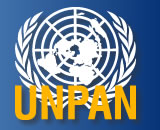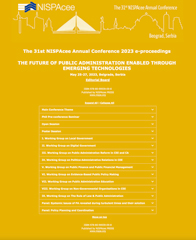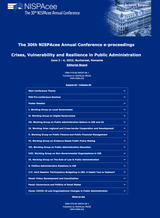| WG_News :: About WG :: Coordinators :: Activities :: WG_outputs |
Background
- Over the last decade most transition countries in Central and Eastern Europe have tried to 'governmentalize' their executives or transform them from subordinate administrative bodies into 'political government' after the disappearance of the communist party . In essence this process has been about reconfiguring political guidance mechanisms within the executive with a view to ensuring a smooth translation of the political leadership's priorities into sound public policies. The working group will position its research within this broad tradition of core executive studies.
- If political government is to prevail over a government of technical bureaucrats on the one hand and a government of vote-maximizing politicians on the other, the 'central minds of government' need to be reinforced . In the first place this involves the reinforcement of the core executive's capacity to ensure a strategic orientation in decision-making. Ways to develop strategic capacities at the centre of government are the key theme for the working group.
- The negative legacies of central planning contributed to a wider neglect of strategically guided policy-making in Central and Eastern Europe. At present strategic decision-making is weakly developed in the region for reasons of skills, structures and knowledge. The role models of a technocratic expert or political advisor with limited policy know-how have dominated policy-making. Ministerial administration has continued to be sectoralized and vertically segmented, with horizontal integration confined to the top level. This has undermined inter-agency coordination and has discouraged attempts to introduce horizontal, cross-cutting aspects into the preparation and implementation of policies. Finally, the knowledge base of decision-making has been weak, given the intransparency and lack of communication between ministerial bureaucracies. Policies to overcome these deficiencies were discussed in the working group.
- The effects of institutional arrangements on policy performance have recently become subject to more systematic research. Recognizing the relevance of institutions for policy performance, international agencies are applying new diagnostic and monitoring instruments. The World Bank and the OECD are developing second generation governance indicators, the EU Commission has elaborated detailed indicators of progress in EU accession and uses benchmarks in its open method of coordination. The working group will provide a vehicle for the further development of performance diagnostics in order to improve the knowledge base for decision-makers and planners in CEE governments.
Research guidelines
The focus of the Working Group for the 12th NISPAcee Annual Conference in 2004 was twofold:
-
the development of institutional arrangements at the centre of government for enhancing strategic leadership;
Papers were invited to study the development of institutional arrangements that enable core executives to ensure a strategic orientation in government action. In institutional terms the focus here will be in particular on:
- political cabinets of the chief executive
- cabinet or government offices
- forward or strategic studies units
- government-sponsored think tanks
- government legislative centres
- finance ministries
- EU integration secretariats
- government commissioners/plenipotentiaries
- coalition management mechanisms
Papers were invited to do all of the following:- (a) describe cross-temporal changes in resources available to such institutions (personnel, finance, organization, etc);
- (b) identify practices, processes or channels through which such institutions are involved in government decision-making;
- (c) analyze the political process behind the building of such institutions (organizational dilemma, relations with political actors, reform strategies, etc).
Papers should have trace the development of strategic leadership capacities in a single or multi-country framework. While generalized accounts of institutional arrangements are preferred, papers addressing particular policy fields are also welcome (e.g. budgetary policy, EU integration, public sector reform).
Papers should have adopted an explicit research methodology (qualitative or quantitative) and been guided by a rigorous analytical/theoretical approach.
-
the impact of different institutional arrangements on strategic decision-making in central government;
Papers should largely adopt an evaluative perspective and should study the effects of different institutional arrangements at the centre of government for the process and outputs of governmental decision-making. They should do all of the following:- (a) develop performance indicators (both qualitative and quantitative) that will measure the extent to which government action is driven by strategic orientation. These may refer both to procedural and substantive aspects of policy making (e.g. reliability of government long-term commitments, quality of legislative preparation process, etc).
- (b) suggest explanations that link cross-sectoral or cross-temporal variation in performance scores to changes in institutional arrangements at the centre of government (see above for a non-exhaustive list of institutions). Papers should develop and test hypotheses with regard to policy effects of different institutional configurations.
- (c) formulate generalizable recommendations on institutional best practices that contribute to high quality strategic leadership.
Papers studied institutional effects in a single-country or multi-country framework. Cross-sectoral studies were also welcome.
Papers should have adopted an explicit research methodology (qualitative or quantitative) and been guided by a rigorous analytical/theoretical approach.
The Working Group on Strategic Leadership in Central Government at its meeting at the 13th NISPAcee Annual Conference in 2005 in Moscow explored whether and how changes within the executive can improve the quality of lawmaking, implementation and governance. With respect to intraexecutive relations, the members of the working group agreed that executive capacity is strengthened by reinforcing the incentives for collective/ centralized decision making. With regard to the relations between the executive and extra-governmental actors, there was disagreement as to the extent of participation needed to enhance the long-term orientation and cognitive openness of policy-making. Whereas a powerful and cohesive executive can contain tendencies of regulatory inflation and overcome opposition to reform, external embeddedness of the executive is required to ensure democratic legitimacy and sustainability of policy reforms. We find, however, that in some cases accountability and executive centralization reinforce each other. The working group plans to proceed from these findings and will, in its future work, further elaborate its findings on the impact of executive reforms on policy outcomes.
The following papers were published in the Conference Proceedings 2005 "Challenges and Responses for the XXI Century",edited by Allan Rosenbaum, Juraj Nemec:
A. Dimitrova, Ellen Mastenbroek,University of Leiden, The Netherlands
Paper: Involving Parliament in in EU Affairs: The New Member States and the Danish Model
O. Protsyk, European Centre for Minority Issues, Ukraine
Paper: Cabinet Decision-Making in the Western CIS countries: The Dual Executive and The Diffusion of Policy-Making Authority
A.Bagenholm, Goteborg University, Sweden
Paper: Enhancing Governmental Legislative Capacity? An Analysis of the Effects of Decision making reforms in Lithuania and Romania
G. Haynal, Hungarian Institute of PA, Hungary
Paper: Bureaucratic Incapacity in Transition Democracies: A Case Study of Decision Behaviour in Hungarian Central Government Organisations
Cooperation between WG II and WG III in 2005 - 2006
A subgroup on Impact assessment methodology was formed as part of the Working group on Public Sector Quality(WG II)in 2005.
During the conference session in Moscow 2005, it became clear that it is better to assess the quality of IA not in isolation but in conjuction with other processes connected with legislative drafting and therefore the subgroup decided to start cooperation with Working Group on Strategic Leadership in Central Government. Therefore, the coordinators suggested to merge the cooperation of the two working groups. The subsection of the WG 2 related to central government operations merged with the Working Group 3.
The group under the leadership of Radoslav Zubek, Katarina Staronova and Martin Brusis prepared the qualitative follow up.
The NISPAcee Working Group on Strategic Leadership in Central Government met in May 2006 in Ljubljana to discuss the relationship of executive capacity and regulatory quality in Central and Eastern Europe. Regulatory quality characterizes legal regulations that are knowledge-based, consider policy externalities and interdependencies and represent a longer-term perspective. The debates of the Working Group sessions confirmed that the organization of executives is a crucial variable for the quality of regulations. However, the papers presented in Ljubljana also indicated how difficult it is to enable governments to produce high-quality regulations.New Public Management ideas do not provide a panacea as the behavioural and cultural assumptions underlying these ideas may be fundamentally challenged on the basis of a critical theory approach that transcends the paradigm of instrumental rationality. Improving the knowledge basis, technical sophistication and power resources of executives will not ensure high-quality regulations if the accountability-generating functions of extra-governmental actors are neglected.
The empirical case studies of the workshop documented the gap between legal design and legalist reforms on the one hand, patterns of de-facto interactions and incentives on the other. Attempts to establish a more policy-oriented preparation of proposals for cabinet meetings in Romania may fail as they presuppose civil servants thinking strategically and the necessary incentive space conceded by politicians to such civil servants. The difficulty of changing mindsets and habits were also manifested by a Romanian opinion survey that found an awareness gap between civil servants committed to reform and the general civil service.
European Union expectations and requirements have driven central government and legislative reforms in many countries of the region. The impact of this constellation has been ambivalent: a paper on Bulgaria noted the persistent deficiencies in policy performance, and a paper on Slovakia documented the shift towards a predominance of the executive and government-sponsored bills. Even a pioneer of executive reform like Hungary today faces institutional obstacles in coping with challenges of globalization and economic policy. One conclusion that emerged from the debate is that procedural and organizational reforms need to be embedded in a human resource management policy and backed by a broad political support coalition.
The coordinators of the WG selected presentation for the stand-alone publication that was published by NISPAcee in 2007.
Strategic Policy Making in Central and Eastern Europe
Edited by Martin Brusis, Katarina Staronova, Radoslav Zubek
|
• 14th NISPAcee Annual Conference 2006
Invitation and Call for papers for WG III
• 13th NISPAcee Annual Conference 2005 • 12th NISPAcee Annual Conference 2004 - List of accepted papers and draft abstracts • High Level Meeting on THE CAPACITY TO GOVERN IN CENTRAL AND EASTERN EUROPE, Prague, December 2003 - Information from the meeting |
2Yehezkel Dror, The Capacity to Govern: A Report to the Club of Rome, London: Frank Cass, 2001.




 Price:
Price: 








